A laboratory is a site for the production of knowledge about usually-yet-unknown details of the world we live in. Normally, scientific labs are accessible only by a small circle of experts and are off limits to the general public. Not so with the EARTH LAB exhibition running June 21-September 25, 2016 in the former Red October chocolate factory in the heart of Moscow. The subject of the experimentation here is nothing less than our entire planet.
This exhibition produced jointly by Moscow’s Polytechnic Museum and Ars Electronica Export focuses on social, ecological and economic phenomena that will have a major impact on the future of our Blue Planet. The wide-ranging points of view of Russian and European artists subject our global habitat to comprehensive scrutiny. And this artistic approach is precisely what’s meant to motivate us to reconsider and reorient how we see Earth’s future. We recently had a chance to sit down with EARTH LAB’s two curators, Natalia Fuchs of the Moscow Polytechnic Museum and Manuela Naveau of Ars Electronica, and go into detail about this exhibition.
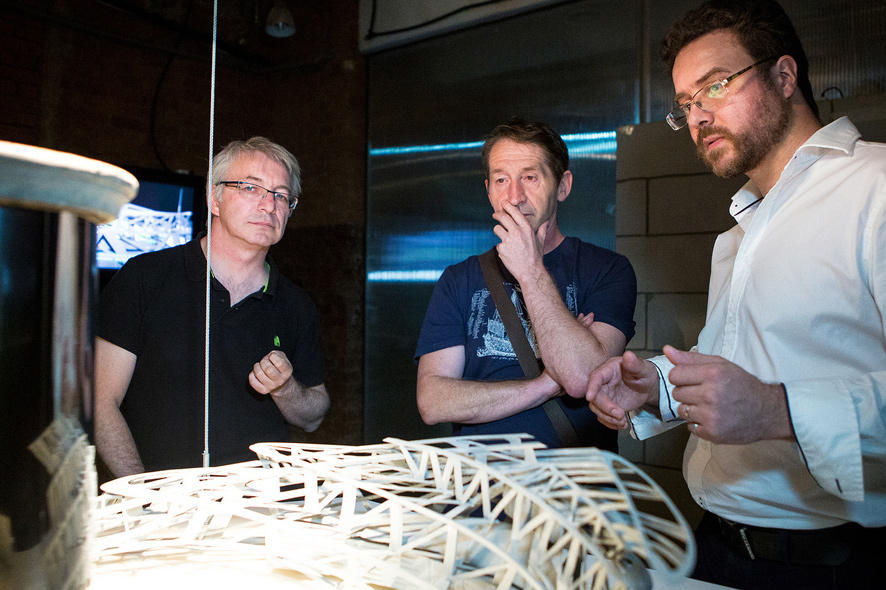
Credit: Daniil Primak, Polytechnic Museum
Planet Earth as the setting of a laboratory—what were the reasons for opening up a discussion of this theme with an exhibition?
Manuela Naveau: For me this idea started when Ars Electronica did a recent exhibition in Gijon at LABoral 2015. In Spain, we created various labs—a GeoLab, a BioLab and a PhilosophyLab, for example—in which we didn’t want to go with a classical presentation style, but rather the process-oriented approach that we’ve been featuring at the Ars Electronica Center since 2009. Taking the next step to EARTH LAB was a logical spinoff—what if we focus not only on geological, biological issues and these kinds of questions, but rather see the Earth itself as a test environment? How do we in Europe see our planet; how do people in Russia see it, and what is actually happening on our shared Mother Earth? To what extent do we understand our world? And which perspectives do we have to take into account in order to understand the different “lab approaches” that exist? I also love the metaphor of a lab for a place for knowledge to be generated. And to critically questioning the different interests that are behind the generation of new knowledge. Who is supporting which experiment and why? And what kind of knowledge is being made public, and which is not? And aren’t we sometimes generating even more non-knowledge than profound insights regarding ourselves and our relation to our environment? When I shared my first ideas with Natalia Fuchs, I had the feeling of intellectual sisterhood. Natalia brought in the “artist as catalyst” aspect and we found that we had come up with a shared way in which we want to go, without having to go through a lot of preliminary curatorial talks.
Natalia Fuchs: I think that it’s actually a very natural form of representing contemporary art practice. Those artists working with digital technology and science always start with research, with experimentation conducted in a lab setting, a lab environment, and a lab concept, so to speak. So the reason for this was the necessity of explaining in all possible ways to the society how much of a philosophical background is inherent in that modern approach, and how much innovation. We set up EARTH LAB to let visitors—professionals and a general audience—ask questions, spend time in the space where ideas are welcome to be shared; to be creative and thoughtful.

The former choclate factory Red October in Moscow, Credit: Manuela Naveau
The EARTH LAB exhibition is situated in the basement of the Red October chocolate factory. Could you tell us a little bit about the history of this special site?
Natalia Fuchs: Red October is one of the oldest factories in Moscow; it’s located in the heart of the city, on an island, not far from the Polytechnic Museum, a historical building that’s under reconstruction until 2017. Therefore we’ve been working with special locations for our exhibition projects over the last five years. We have worked at many venues—several pavilions at VDNKh, Multimedia Art Museum, Strelka Institute, Garage Museum of Contemporary Arts and others. This is the first time we’re collaborating with Red October. A few years ago, it became a cultural quarter where young people like to congregate—there are many nice shops and cafes, clubs are around, so it’s a vibrant, lively setting for the EARTH LAB—the best that we could imagine, actually!
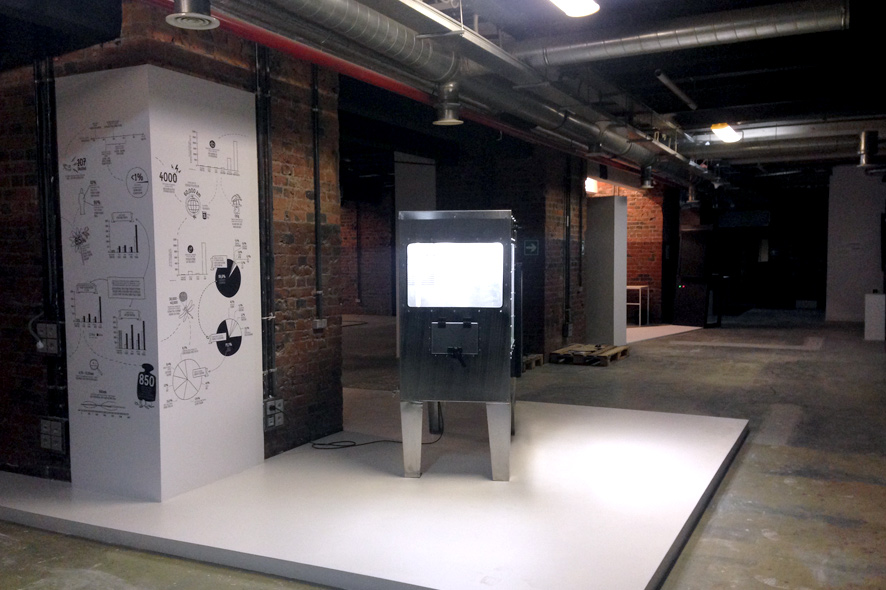
Credit: Manuela Naveau
How is the exhibition structured and what can visitors expect to see in the EARTH LAB?
Manuela Naveau: We somehow wanted to generate a space that looks like an underground laboratory where secret tests and strange experiments take place. Living organisms are confronted with inert materials; invisible parameters have an effect on processes in the exhibition, and factors whose influence is all too visible can be discussed. And “Mrs. Coincidence” is the guide! There are sculptures out of physical material and out of data; you can find installations and interactive settings and ever-changing processes that support the idea of considering the Earth as a lab. Most important—the whole framework that consolidates the various works in the exhibition is a specially developed infographic. Together with the possibilities of Shadowgram—an artwork as a participative brainstorming tool developed by Ars Electronica—the exhibition’s graphics are complemented by the visitors’ stickers and speech balloons of their own thoughts and designs, and will extend throughout the whole exhibition area. An ever-changing face of the exhibition during its three-month run …
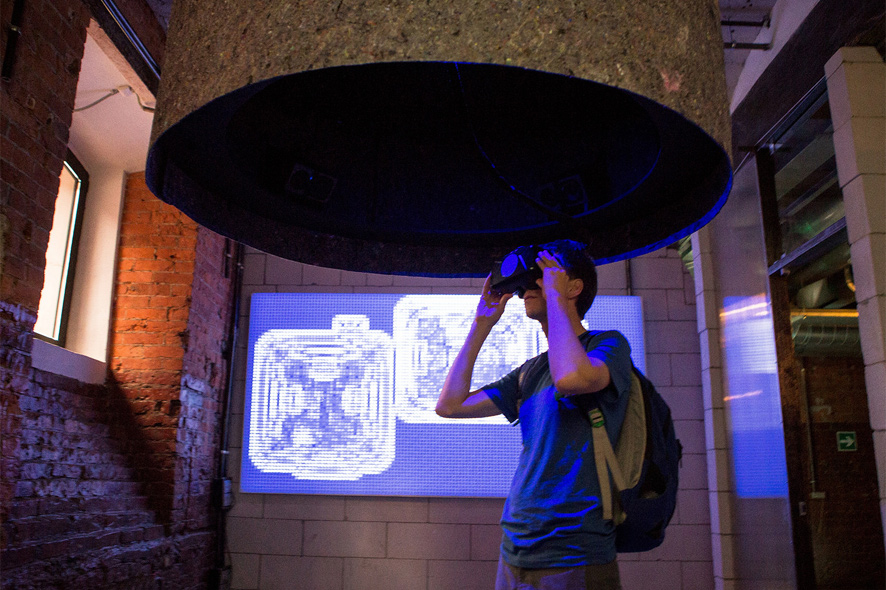
Credit: Daniil Primak, Polytechnic Museum
What are your favorites in this exhibition?
Manuela Naveau: Well, that’s really hard for me to say at the moment! We specially commissioned new Russian works for the exhibition and they’re really exciting! Of course all works caught our attention, and this is why they’re in the exhibition, but I have to say that one work especially touched me more and more after we actually confirmed it. Sonja Bäumel is working with the situation that our body actually consists of only about 10% human cells. All others are non-human bacteria and other microbes. She is asking if it is perhaps the case that microorganisms are what ultimately govern the human species? And what she is creating within the duration of the exhibition is actually a bacteria-bomb, whereby only certified lab technicians are allowed to open the nearly human-size Petri dish in which she’s growing her body imprint on a microorganism level. Nobody knows—neither she nor associated researchers—can exactly forecast what will happen in the Petri dish in our underground exhibition. And it’s not only visually exciting, I believe!
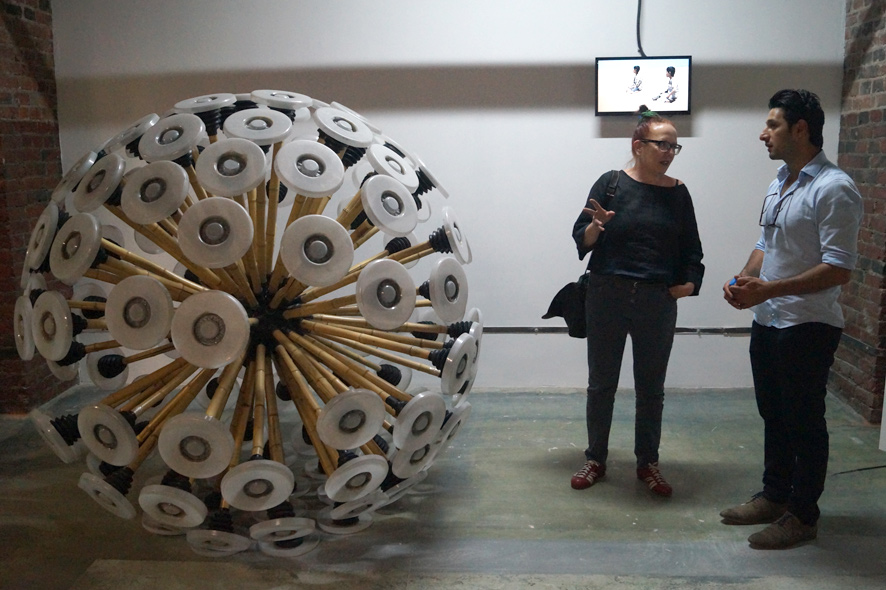
Credit: Manuela Naveau
Natalia Fuchs: I am very happy about Russian artists participating in this exhibition ::vtol::, Dmitry Bulatov and Alexey Chebykin, Vadim Kolosov, Yulia Glukhova, STAIN. All of them have new pieces to premiere at our joint exhibition with Ars Electronica. I am very much into sound, so I love all the projects that have a lot to do with sound perception. I love the robotic installation by Leo Peschta. Der Zermesser is absolutely amazing; it’s my favorite robot on the whole planet at the moment. Mine Kafon by Massud Hassani speaks so well about historical memory. Last year during the reconstruction of the Polytechnic Museum, we discovered a bomb from the time of World War II in the deep basement—this is right in the center of Moscow, you know—and we had to unearth it. So it’s very close to our own history and to the impact that war has had on it, definitely. I love the fact that Sonja Bäumel’s artwork “Expanded Self II” was done together with the lab at Moscow’s Orekhovich National Research Institute of Biomedical Chemistry, and we’re going to develop a new joint project with them too. The most meditative artwork is the Earth by Finnbogi Petursson, of course. I’m sure I will spend a lot of time during these next three months of the exhibition feeling the pulse of our planet.
Additional information about “EARTH LAB – Artists as Catalysts” is available at export.aec.at/earthlab. EARTH LAB is running from June 21 to September 25, 2016 at the former Red October chocolate factory in Moscow. The exhibition is open to the public.
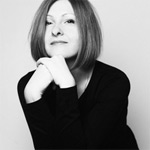
Natalia Fuchs is an expert in art and culture management and international public relations. She is a graduate of the University of Manchester, UK (Cultural Management, 2008) and Leonardo scholarship winner at the History of Media Arts program of Donau-Universität (low-residence, Austria). In 2013 she was invited by the Polytechnic Museum in Moscow to create and curate interdisciplinary program Polytech.Science.Art what she is doing currently, together with curating exhibitions and Electronic Livingroom, experimental multifunctional space at the Polytechnic Museum. As a researcher and practitioner, she works in a variety of topics and participate different international projects focused on contemporary culture, media art, cinema and sound.
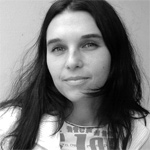
Manuela Naveau lives and works in Linz, Austria. Since completing her studies at Linz Art University, she has worked as an artist and curator in Austria and abroad since 1997. She returned to Linz in 2003 to assume curatorial and project management responsibilities at Ars Electronica. In collaboration with Gerfried Stocker, artistic director of Ars Electronica Linz GmbH, Manuela Naveau developed the Ars Electronica Export division, which she has headed since its inception. In addition to curating, producing and placing Ars Electronica exhibitions at museums and institutions worldwide, her interest is focused on the manifold manifestations of contemporary artistic practice.
